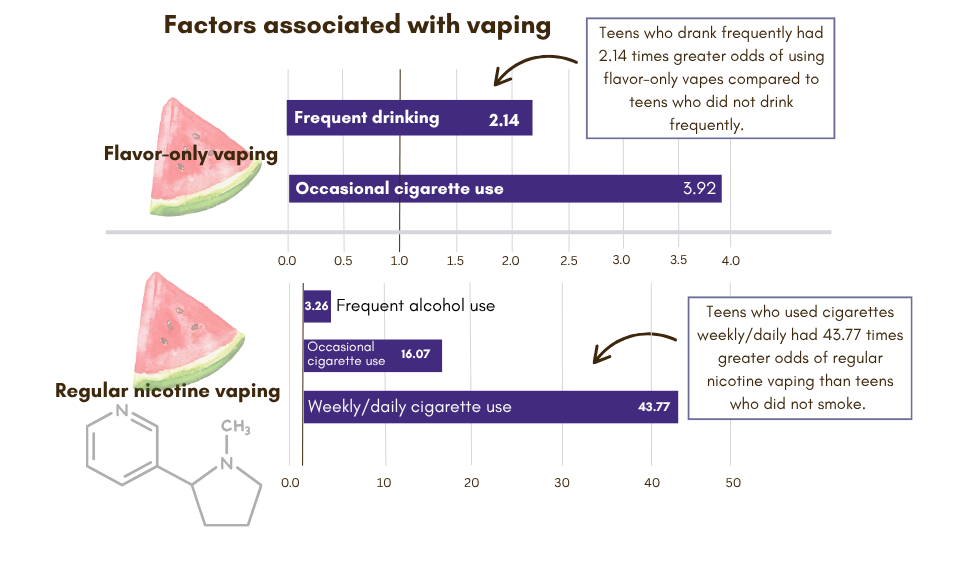Youth vaping remains a significant public health concern. Of particular note are flavored vapes that have faced additional scrutiny over recent years and may be especially attractive to youth. Manufacturers have also begun producing nicotine-free vapes, though these too are associated with health risks. To minimize public health harm, it is important to understand how flavor-only vapes compare to nicotine vapes. For example, while alcohol and cigarette use are risk factors for nicotine vaping, does this remain true for flavor-only vaping? This week, ASHES reviews a study by Janni Leung and colleagues that explored the risk factors associated with flavor-only vape use and nicotine vape use among youth.
What was the research question?
Which risk factors are associated with flavor-only and regular nicotine vaping among youth?
What did the researchers do?
The researchers used data from a cross-sectional survey of 855 Australian 12th graders. Participants answered questions about their sociodemographic characteristics, academic performance, and mental health. They also provided information on their e-cigarette use. The research team used these data to identify three groups of participants: (1) never vaped, (2) used flavor-only vapes, and (3) used nicotine vapes (inclusive of participants who used flavored-only and nicotine vape users). The researchers used regression analyses to identify which characteristics were associated with the different categories of vape use.
What did they find?
The majority of participants (79.4%) reported that they have never vaped, 12.5% reported flavor-only vaping, and 13.5% reported using nicotine vapes. Most participants likewise reported that they have never smoked a cigarette (79.4%) though 14.9% reported occasional use and a further 5.6% reported weekly/daily use. Male gender was the only predictive sociodemographic characteristic: boys were more likely than girls to use flavor-only vapes. As with nicotine vaping, teens who drank frequently and smoked cigarettes were more likely to use flavor-only vapes (see Figure).

Figure. Displays the odds of reporting either flavor-only vape use or nicotine vape use based on participants’ cigarette and alcohol use. All effects are statistically significant. Click image to enlarge.
Why do these findings matter?
The fact that frequent drinking and cigarette smoking were the strongest predictors of flavor-only and nicotine vaping suggests that nicotine cessation programs may benefit from focusing on underlying risk factors for substance (mis)use, generally, such as sensation seeking and impulsivity. Though most interventions often focus on encouraging abstinence from specific substances, the syndrome model of addiction suggests that some individuals can carry an underlying vulnerability to addictive behaviors that manifests when exposed to an object of addiction. If those underlying vulnerabilities are not addressed during treatment, there is a greater possibility of these patients simply switching to another addiction.
Every study has limitations. What are the limitations in this study?
This study used cross-sectional data, meaning it is unclear whether vape use was initiated before or after the use of other substances. E-cigarette use was coded as either used or never used, which does not account for the frequency of use.
For more information:
Individuals who wish to stop or cut back on their nicotine use may benefit from visiting the CDC webpage on smoking cessation. Others may benefit from visiting the American Lung Association’s quit smoking webpage. Additional resources can be found at the BASIS Addiction Resources page.
—John Slabczynski
Want CE credit for reading BASIS articles? Click here to visit our Courses Website and access our free online courses.




